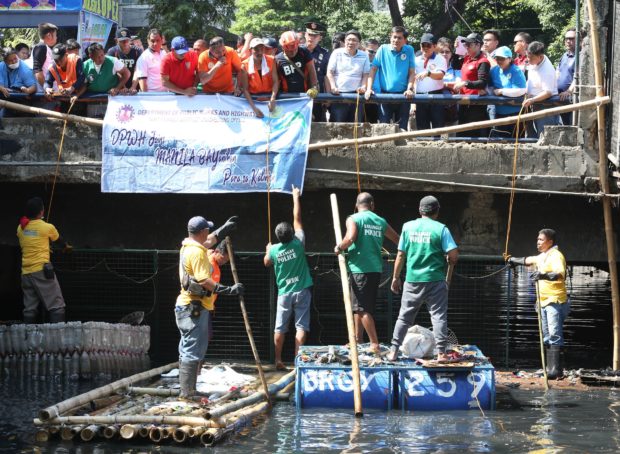Marawi evacuee must ‘flee’ again due to Metro waterway cleanup

SIMULTANEOUS CLEANUP Environment Secretary Roy Cimatu, Interior Secretary EduardoAño and Metropolitan Manila Development Authority Chair Danilo Lim oversee the clearing of Estero de Magdalena in Tondo, Manila, on Sunday, part of the simultaneous cleanup of esteros linked to nine rivers that feed into Manila Bay. —MARIANNE BERMUDEZ
MANILA, Philippines — When bombs began to rain on her Marawi City neighborhood in 2017, Subaida Mangutara was left with no choice but to flee.
The 69-year-old woman found refuge in the company of her daughter Rakima, who for years had lived at the border of Parañaque and Pasay cities, far from their native land.
But while away from strife, Mangutara’s new dwelling was far from ideal. Along with other displaced families, home was amid heaps of garbage and human waste thrown into Estero Tripa de Gallina.
Facing demolition
The entire family, however, would soon be uprooted again, after the government marked their makeshift home as one of the thousands that would be demolished in the ongoing effort to clean up the waterways that flow into Manila Bay.
Article continues after this advertisementInformal settlers living along riverbanks and on estuaries in Metro Manila had long been blamed for the pollutants that end up in the bay.
Article continues after this advertisementUrban blight
A ballooning urban population, alongside the neglect of environmental laws, has contributed to the blight most evident in the poorest pockets of Metro Manila.
While many informal settlers like Mangutara embraced the idea of a cleaner environment, anxiety continues to grip them.
On Sunday, Environment Secretary Roy Cimatu assured Rakima and other families living along Tripa de Gallina that they would be transferred to a place with better living conditions.
Nine rivers
Cimatu, along with Interior Secretary Eduardo Año and Metropolitan Manila Development Authority Chair Danilo Lim, traveled across the metropolis to oversee the simultaneous cleanup drive in nine rivers that feed into Manila Bay.
Among these are Tinajeros River, Tullahan River, Pasig River, Marikina River, Las Piñas-Zapote River, Taguig-Pateros River, Malabon-Navotas River, San Juan River and Parañaque River.
Tripa de Gallina flows into Parañaque River.
“We just hope that we would be relocated to a better place, not to another place of conflict,” Mangutara said. “If they will just send us back to Mindanao, we don’t want to go back there.”
Cavite, Bulacan relocation sites
The relocation of informal settlers is part of the second phase of the ambitious bay rehabilitation program dubbed the “Battle for Manila Bay.”
Cimatu earlier said that local governments should be on top of relocating more than 230,000 families along esteros, in coordination with the newly formed Department of Human Settlements and Urban Development.
“Right now, we have around 11,000 units available for relocation in Cavite and Bulacan provinces,” Año told reporters on Sunday. “The receiving local government units should also be prepared.”
For Zenaida Bibat, 74, and Tita Mora, 85, the demolitions should be expected and accepted by those living along the river.
As longtime residents at the Parañaque side of Tripa de Gallina, both women have seen how the waterway has changed over decades of urban decay.
“I know that a part of my house might be destroyed once they enforce the three-meter easement,” Bibat said. “But it’s alright because we have to follow the law.”
Joseph Vakunawa, 38, and Mary Aileen Wong, 34, however, offered a somber tale for the thousands who would soon face the government’s whip against informal settler communities.
The couple used to live in a house on stilts that stood on Estero de Magdalena in Manila, where trash had accumulated so much that the water was then almost impossible to see.
No jobs at relocation
In February 2017, they were among the hundreds of families relocated to Pandi, Bulacan province. But the promise of a new beginning was still far off, with no jobs anywhere nearby.
“So we return here because this is where our livelihood is,” said Vakunawa, who sells cell phone accessories on Claro M. Recto in Manila.
Standing on the ground where their house once stood, the couple watched volunteer workers scoop out plastics and other junk from Magdalena, already black from mud and silt.
Even with a new roof over their heads, the couple would rather sleep on the streets on days they have to make ends meet in Manila.
“We would not return here if we can actually live in our new community,” Wong said. “But how can you stop people from returning when there’s nothing to eat there?”